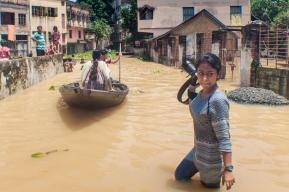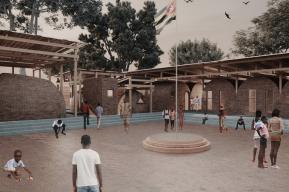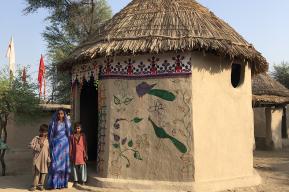فكرة
أستراليا: في مواجهة النّيران

ملايين الهكتارات من الغطاء النّباتي التهمتها النّيران وهُلكت حوالي ثلاثة مليارات من الحيوانات. تلك هي الحصيلة المرعبة للحرائق الهائلة التي نشبت فيما بين 2019 و2020. وسوف يتطلّب تعافي التنوع البيولوجي وقتا طويلا لتجاوز هذه المحنة، لا سيّما وأنّ الظّروف المناخية للسنوات القادمة ليست مواتية.
غاري نون
صحفي مقيم بسيدني، أستراليا
"إن ما يُثير الانتباه عندما نسير في غابة دمّرتها النيران هو غياب الضوضاء. لا صوت لزقزقة العصافير ولا لخشخشة أوراق الشجر. إنّه الصمت المطبق". هذه العبارات لمايك كلارك، أستاذ علم الحيوان بجامعة لا تروب في ملبورن، يمكن أن تنطبق على العديد من الغابات الأسترالية التي أبادتها مؤخرًا حرائق الغابات وأخمدت صوتها.
ويُضيف مايك كلارك: "إنها، بلا شكّ أسوأ كارثة في تاريخ أستراليا". فمن الصّعب تخيّل مساحة المنطقة التي اشتعلت فيها النيران إذ بلغت 13 مليون هكتار. وحتى نحصل على فكرة عن أهميّة هذه المساحة، فهي أوسع من مساحة هولندا والدنمارك وسويسرا مجتمعة.
ولئن بلغت النّيران مثل هذا الحجم، فلأنّ الوضع المناخي كان مُلائما. يقول مايك كلارك: "لقد أتت النيران لتنضاف إلى أسوأ سنوات الجفاف التي لم تشهد أستراليا مثيلا لها. فالحيوانات كانت مُرهقة للغاية من قبل. وستكون الظروف المناخية للثلاث سنوات أو الأربع القادمة حاسمة لاستعادة التنوّع البيولوجي الأسترالي."
خسائر فادحة
وفق دراسة نشرت في يوليو 2020 من طرف عشرة علماء ينتمون إلى خمس مؤسّسات معتمدة من طرف الصندوق العالمي للطبيعة WWF، فرّ حوالي ثلاثة مليارات من الحيوانات أو أتت عليها النّيران. ففي تصريح أدلى به إلى صحيفة الغارديان، يقول كريستوفر ديكمان، أستاذ الأوساط البيئية الترابية بجامعة سيدني المشرفة على المشروع، أنّ هذه الاكتشافات خلّفت صدمة كبيرة حتّى لدى الباحثين، "فثلاثة مليارات من الحيوانات المحلية رقم مهول للغاية. ومثل هذا الرّقم الذي لا يصدّق غير قابل للإدراك".
وهو رقم جزئي حسب مايك كلارك إذ "لا يشمل سوى الثّديّيات، والطّيور، والزّواحف. أمّا إذا ما أضفنا اللاّفقاريات، فالرّقم يفوق الخيال".
لا شكّ أن الغطاء النّباتي الأسترالي كان دوما عرضة للنّيران. ويُوضّح آلان يورك، أستاذ علم بيئة الحرائق بجامعة ملبورن: "إنّ ما هو غير مسبوق ليس خطورة هذه الحرائق بل حجمها الاستثنائي لأنّها أتت على أماكن كثيرة، ولكونها، أيضا سابقة لأوانها إذ اندلعت في أوّل بدايات الموسم العادي للحرائق، بل حتّى قبل أن ينطلق الموسم أصلا."
ويمكن لتبعات هذه الحرائق على الأجناس المهدّدة بالانقراض في أستراليا أن تكون مدمّرة حيث يُؤكّد مايك كلارك بأنّ "سبعين جنسا من الأجناس المهدّدة على المستوى الوطني فقد نصف موائله، على الأقلّ، بعد أن تحوّلت هذه الأخيرة إلى رماد". تلك هي الحال، بالخصوص، بالنّسبة إلى فأر البوتورو طويل القدمين، وطائر الكاكاتويس الأسود اللمّاع المقيم بجزيرة كانجارو، "وهو طائر نادر ولافت للانتباه"، فالحرائق دمّرت إمّا مصادر غذائها أو موائلها أو الاثنين معا.
كما دُمّر معظم موائل حيوان الكوالا المتوطّن شمال نيو ساوث ويلز. غير أنّ مايك كلارك يضيف بأنّ المكانة الرمزية للكوالا تُخفي أحيانا كوارث أخرى بالنسبة للمنظومة البيئية لأنّه "يُعتبر بمثابة نجم هذه الأزمة، والحال أنّ هناك، في الواقع، مجموعة كاملة من الأجناس الحيوانية مثل الأوبُصوم الكبير أو النّباتات المختلفة التي تعيش وسط أنواع معينة من الأوكالبتوس، المعرّضة حاليًا إلى الخطر."
الغطاء النباتي الأسترالي وقدرته على الصّمود والمقاومة
قد تستغرق عودة هذه الأنواع والأجناس عدّة سنوات، وقد يتطلّب ذلك، في بعض الحالات، تدخلًا بشريًا مثل تربية الضّفادع في أماكن مُغلقة بحدائق الحيوان الأسترالية. يقول آلان يورك "ما زلنا نأمل، رغم كل شيء، أن تكون الحيوانات التي احتمت بالجيوب التي لم تتأثر بالحرائق، باقية على قيد الحياة". ويحتفظ الأستاذ بقدر من التفاؤل، معتمدا على "القدرة الاستثنائية [للغطاء النباتي الأسترالي] على استرجاع الحياة صلبه".
بيد أنّ هذا الرّهان على المستقبل غير مضمون النتيجة. فالغابات الاستوائية الرّطبة والمناطق المرتفعة في تسمانيا غير المُتعوّدة على الحرائق، هي الأكثر هشاشة وعُرضة للحرائق المتكرّرة. ومع تسارع التغيّرات المناخية، فإنه لا مفرّ من تزايد هذه الحرائق.
هذا وقد تتسبّب بعض "التدخّلات البشرية" في الخفض من سرعة استرداد الغطاء النّباتي، لاسيّما تدمير الموائل أثناء عمليّة استصلاح الأراضي، وعدم اتّخاذ التّدابير الضرورية في مجال مكافحة التغيّر المناخي.
يبقى السؤال عمّا إذا كان للغطاء النباتي القدرة الكافية على المقاومة ليستعيد عافيته؟ حول هذه النّقطة بالذات تختلف الآراء. يقول مايك كلارك: "إنّ حوالي %70 من الغابات الاستوائية الرّطبة قد احترقت، أي الجزء من المشهد الطبيعي غير المُتعوّد على التكيّف مع النار، لذا نحن لا نعرف حقًّا ما إذا كانت ستتجدّد، وكيف سيتمّ ذلك".
إعادة إحياء بطيئة جدّا
ذلك أن الكثير من الموارد قد احترقت في حين تحتاج بعض الأنواع مثل الكاكاتويس أو الببغاء أو الأبوصوم أو الخفاش إلى الجذوع الجوفاء المتبقية في الأرض أو سيقان الأشجار لإنشاء مساكنها أو للتكاثر. غير أن هذه الجذوع لم تُسحق فحسب، بل سوف تستغرق عودتها إلى الظهور قرنًا أو قرنين من الزّمن حسب تقديرات مايك كلارك. فالأشياء التي اختفت خلال ساعات قليلة جرّاء حرائق الغابات قد تستغرق قرونًا قبل أن تعود إلى الحياة. ذلك ما يسمّيه دعاة حماية البيئة "التغيّر الشّامل للوضع".
إن التّربة عامل أساسي في استعادة الحياة. إلا أن مساحة الأرض التي تكلّست أثناء الحرائق فاقت المعتاد نظرا للجفاف الذي عمّ في السنوات الأخيرة ودمّر الرّطوبة التي كانت موجودة فيه سابقًا. وبالتالي فإن العناصر الغذائية الأساسية الملازمة للتربة اختفت بدورها.
ضرورة اتخاذ إجراءات فورية
يطالب الخبراء باتّخاذ تدابير فورية لتسهيل استعادة هذه المساحة الشّاسعة. ولقد تمّ اقتراح إرجاء استغلال الغابة، إضافة إلى الضّغط المتزايد للحثّ على مكافحة القطط والثّعالب الوحشيّة بأكثر حزم، وتنظيم حملات لمكافحة الأعشاب الطّفيلية.
كما أنّ تحديد المناطق التي لم تحترق وحمايتها يُمثّلان موضوع نقاش أساسيّ. فالبعض يعتقد أن الحرق الزّراعي قد يكون وسيلة للوقاية من النّار أكثر ملاءمة من الاحتراقات المرتفعة الحرارة والكثيفة. وتتمثّل هذه التّقنية، التي مارسها السكّان الأصليون بانتظام على كامل الأراضي قبل استعمار أستراليا بمدّة طويلة، في إشعال نيران لا يتجاوز ارتفاعها مستوى الرّكبتين وبدرجة حرارة منخفضة ممّا يسمح بحرق المواد القابلة للاحتراق التي تكسو الأرض (حطام الخشب، الأوراق اليابسة، إلخ) لمنع حرائق الغابات الطبيعية من استغلالها كوقود.
وأخيرا، فإنّ التّدابير الملموسة لمكافحة التغيّر المناخي تعتبر عاملا حاسما بالنّسبة لمستقبل التنوّع البيولوجي، لأنه رغم قدرة الطبيعة على المقاومة، فإن استعادة التنوّع البيولوجي للغطاء النباتي ما زالت بعيدة المنال. وحسب مايك كلارك، فإنه "إذا تجدّد جزء من الغطاء النباتي، فسيكون ذلك جيدًا، إذ يمكن للثُّلُث أن يتعافى، ويبقى مصير ثُلثٍ آخر غير مؤكّد، أما الثُّلث الأخير فسيُعاني من صعوبة حادّة. فأنا أدرس، منذ عشرين عامًا، الظّروف البيئية المتسبّبة في الحرائق، ومع ذلك نجد أنفسنا اليوم أمام مجال مجهول بصدد التطوّر أمام أنظارنا".
مطالعات ذات صلة
التصرّف في المياه: أستراليا تطوي الصّفحة، رسالة اليونسكو، مارس 2009
حرائق مُربحة، رسالة اليونسكو، يوليو- سبتمبر 1998
معارف السكّان الأصليّين في تقييم التغيّر المناخي والتكيف معه، اليونسكو بالاشتراك مع منشورات جامعة كمبردج، 2018
اشترك في رسالة اليونسكو لمتابعة الأحداث. الاشتراك في النسخة الرقمية مجاني %100.
Gary Nunn
Freelance journalist, based in Sydney.
“When you walk into a forest that’s been burnt this badly, the overwhelming thing that hits you is the silence. No bird-song. No rustling of leaves. Silence.” This is how Mike Clarke, professor of zoology at La Trobe University, Melbourne, described Australia’s many forests that were recently decimated by the country’s worst bushfires.
“This stands out as the worst disaster in Australia’s recorded history,” Clarke says. The figure of the area that has been burnt – 13 million hectares – is “hard to get your head around.” For scale, this is an area bigger in hectares than Holland, Denmark and Switzerland combined. All burnt to a crisp. Homes, forests, animals, plants – all gone.
The timing is also significant in understanding the scale of the impact. “This comes on top of Australia’s driest years on record,” Clarke adds. “Populations of animals were already on their knees due to the drought. Australia’s weather conditions in the next three or four years will be critical to what recovery looks like.”
Unprecedented losses
Three billion animals were killed or displaced in the bushfires, according to a July 2020 study by ten scientists from five institutions commissioned by the World Wildlife Fund for Nature (WWF). Christopher Dickman, professor in terrestrial ecology at The University of Sydney and fellow of the Australian Academy of Science, who oversaw the project, said the study’s main findings came as a shock, even to the researchers. “Three thousand million native vertebrates is just huge. It’s a number so big that you can’t comprehend it,” he told The Guardian newspaper.
This figure is conservative, Clarke believes. “That’s just mammals, birds, reptiles. If we added invertebrates to that, the numbers would be astronomical.”
One thing that must be clear, though, is that Australia’s bush has always burnt quite severely. “The severity isn’t unprecedented,” says Alan York, professor of Fire Ecology at the University of Melbourne. “What is unprecedented is their earliness in, or before, the usual fire season, and the volume of fires in so many places, which is far more unusual.”
The impact on Australia’s threatened species is potentially devastating. Seventy nationally threatened species have had at least half of their habitat burnt, Clarke says. These include animals such as the long-footed potoroo and the Kangaroo Island’s glossy black-cockatoo – “a rare and spectacular bird,” he adds. Fires have burnt their food sources, shelter, or both.
Koalas in northern New South Wales have had most of their habitat burnt. The iconic nature of these animals sometimes overshadows other ecosystem horrors, Clarke says. “They’re the poster child of this crisis. But in reality, a whole suite of wildlife – large possums, all sorts of plants that live in alpine ash, whole communities of organisms – are all at risk now.”
How resilient is the Australian bush?
It may take years for these species to recover. And that may require human assistance – with captive-bred frogs in Australia’s zoos, for example. “Otherwise, we’re hoping animals survived in unburnt pockets,” York explains. He remains somewhat optimistic, saying the Australian bush has a “dramatic capacity to recover.”
There are, however, caveats. Rainforests and alpine areas of Tasmania, for instance, don’t have much experience of fires, so they’re more vulnerable to repeated fires, he says. And under the current climate change model, increasing fires are inevitable.
Under the current climate change model, increasing fires are inevitable
Some of several “human interferences” that’ll most likely hamper recovery include habitat removal from land clearing, and a lack of urgent political action on climate change.
But is the Australian bush really resilient enough to recover? Not everyone shares the fire ecology expert’s tempered optimism. “Seventy per cent of the rainforest has been burnt – it’s the bit of the landscape not adapted to fire – so it’s really unclear how, and if, it’ll come back,” Clarke says.
Seventy per cent of the rainforest has been burnt
A recovery could take centuries
The problem is, lots of critical resources have been incinerated. For example, many fauna – cockatoos, parrots, possums, bats – rely on hollow logs on the ground, or on trees to den in or breed in. Not only have those logs now gone, Clarke predicts that it will take one to two centuries for them to appear again, hollowed out. “What could disappear in hours in bushfire could take centuries to replace. Ecologists would call this a ‘complete state change’.”
An essential ingredient to recovery is soil. More soil than usual was burnt in these fires, as the droughts in recent years removed the pre-existing moisture. This means the essential nutrients held in the soil are no longer there either.
Immediate measures needed
Experts say some immediate steps are being taken to help along the recovery of this vast area. A moratorium on logging has been proposed, and pressure is building to act more aggressively on the pest control of feral cats and foxes, in addition to introducing weed removal. “Weeds recolonize areas disturbed by fire. They use resources that native plants and animals might need,” York explains.
Identifying and protecting areas that did not burn is also an important subject for debate. Specifically, some are arguing that cultural burns may be better than the hotter, more intense, hazard reduction burning. Cultural burns are cool-burning, knee-high blazes that were designed to happen continuously and across the landscape, practised by indigenous people long before Australia’s invasion and colonization. The fires burn up fuel like kindling and leaf detritus, so that a natural bushfire has less to devour.
Since Australia's fire crisis began in 2019, calls for better reintegration of this technique have grown louder. But they may be of limited value at this crisis point, according to Clarke. “We need to appreciate how different things are now. Cultural burns happened to enable people to move through dense vegetation easily, or for ceremonial reasons. They weren’t burning around 25 million people, criss-crossed by complex infrastructure and in a climate change scenario,” he estimates.
Concrete measures to combat climate change are indeed crucial for the future of biodiversity. In spite of green shoots of optimism in some quarters, the prognosis of whether the bush will ever recover its biodiversity is looking somewhat grim. Breaking it down, Clarke surmises that “A chunk of it will be good – a third will be able to bounce back. A third is in question, but a third is in serious trouble. I’ve been studying fire ecology for twenty years, but we’re dealing with unchartered territory changing before our eyes.”

In the same issue







